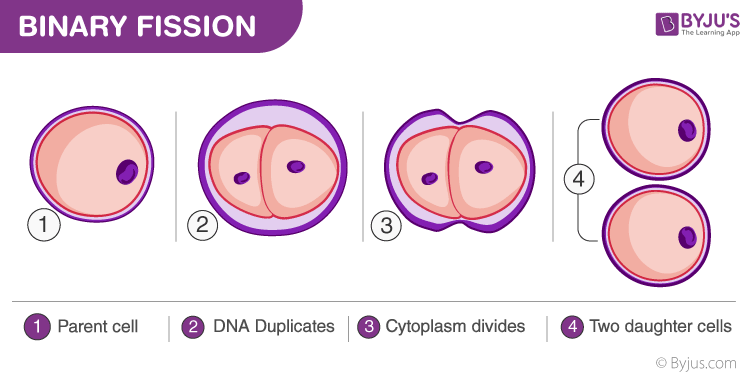Binary fission may be as old as the very first forms of life – over 3.5 billion years old. However, the process has remained unchanged ever since then. Read on to explore binary fission in bacteria and amoeba reproduction in detail.
Binary Fission Definition
“Binary fission is a form of asexual reproduction in which an organism divides into two, each part carrying one copy of genetic material.”
What is Binary Fission?
Binary fission is a type of asexual reproduction typically observed in prokaryotes and a few single-celled eukaryotes. In this method of asexual reproduction, there is a separation of the parent cell into two new daughter cells. This process happens with the division and duplication of the parent’s genetic matter into two parts. Here, each daughter cell receives one copy of its parent DNA.
It is a primary method of reproduction in prokaryotic organisms. Binary Fission occurs without any spindle apparatus formation in the cell. In this process, the single DNA molecule begins replication and then attaches each copy to various parts of the cell membrane. When the cell starts to get drawn apart, the original (actual) and replicated chromosomes get apart.
However, asexual mode of reproduction has a significant drawback. All resultant cells are genetically identical, mirror copies of each other and the parent cell. Most antibiotics work on this principle. If a parent cell is vulnerable to an antibiotic, then all resultant daughter cells are vulnerable too. If a mutation occurs in their genes, then it can render a particular strain resistant to antibiotics.
Prokaryotes such as E. coli, Archaea as well as eukaryotes such as euglena reproduce through binary fission.

Binary fission is a form of cell division in eukaryotes. In prokaryotes, it is a form of asexual reproduction
Binary Fission in Bacteria
The process of binary fission is usually rapid, and its speed varies among species. The time required by bacteria to double the number of cells it has is called doubling time. Furthermore, each species requires specific conditions for its growth. These conditions include pH levels, temperature, oxygen, light, moisture, osmotic pressure.
For instance, mesophiles thrive at moderate temperatures ranging from 20 °C to 45 °C. The ambient temperature of the human body is 37 °C, which means many of the disease-causing bacteria are mesophiles. Mycobacterium tuberculosis is the bacterium that causes tuberculosis in humans. It divides every 15 to 20 hours, which is very slow when compared to other pathogenic bacteria such as Escherichia coli, which can divide every 20 minutes.
On the other end of the spectrum are the extremophiles. These bacteria can survive extremely harsh conditions such as high temperatures, high salinity, highly acidic environments and more. For instance, the Deinococcus radiodurans is an extremophilic bacteria that can survive a thousand times more radiation than a person can. Under normal circumstances, it can divide every 48 hours. However, when exposed to harsh conditions like drought, it can slow down its growth rate until more favourable conditions arise.
Read more: Bacteria
The steps involved in the binary fission in bacteria are:
Step 1- Replication of DNA
The bacterium uncoils and replicates its chromosome, essentially doubling its content.
Step 2- Growth of a Cell
After copying the chromosome, the bacterium starts to grow larger in preparation for binary fissions. It is followed by an increase in cytoplasmic content. Another prominent trait of this stage is that the two strands migrate to opposite poles of the cell.
Step 3-Segregation of DNA
The cell elongates with a septum forming at the middle. The two chromosomes are also separated in this phase.
Step 4- Splitting of Cells
A new cell wall is formed at this phase, and the cell splits at the centre, dividing the parent cell into two new daughter cells. Each of the daughter cells contains a copy of the nuclear materials as necessary organelles.
Amoeba Reproduction-Binary Fission in Amoeba
Amoeba is a unicellular organism, and just like bacteria, it reproduces through binary fission. After replicating its genetic material through mitotic division, the cell divides into two equal-sized daughter cells. In this method, two similar individuals are produced from a single parent cell. An amoeba that is about to undergo division grows larger, and eventually, its nucleus extends and divides into two. The division of cytoplasm follows the division of the nucleus. So, two amoebae are produced from a single parent, and the parent’s identity is technically “lost.”
Read More: Nutrition in Amoeba
To know more, watch the video given below:

Frequently Asked Questions
1. How does Amoeba reproduce?
2. List out the similarities and differences between binary fission and mitosis
Similarities:
-
- During binary fission as well as mitosis, chromosomes are copied before a cell divides and forms two new daughter cells.
Differences:
-
- Mitosis is a process of cell division, observed in all eukaryotes -organisms with a true nucleus.
Binary fission is a process of asexual reproduction carried out by all prokaryotes- organisms without a true nucleus as well as in some eukaryotes.
- Mitosis is a process of cell division, observed in all eukaryotes -organisms with a true nucleus.
3. State the types of binary fission.
Listed below are different types of Binary fission:
- Simple Binary fission
- Longitudinal Binary fission
- Oblique Binary fission
- Transverse Binary fission
Explore more about binary fission in bacteria and amoeba, or other related topics by registering at BYJU’S. Alternatively, discover more interesting topics in biology on BYJU’S Biology.
Further Reading:



This is amazing app I want to study in this app
It is super app but the regeneration explanations can be in pictures so it will be easy to undery
awesome app where i can learn
Hii sir, Is ameoba reproduce by multiple fission in some cases?
Yes, amoeba undergoes multiple fission under unfavourable conditions. When conditions are unfavourable, the amoeba pulls in its pseudopodia and secretes a cyst wall surrounding the cell. The nucleus divides repeatedly to produce several nuclei and each gets surrounded by a small amount of cytoplasm. When favourable conditions return, the cyst wall ruptures, releasing several daughter amoebas.